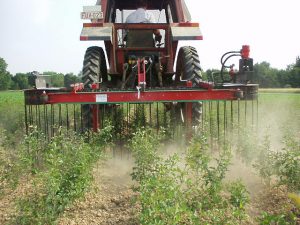08
Sep
GE Crops Lead to Increase in Toxic Herbicide Use
(Beyond Pesticides, September 8, 2016) According to a study published last week by scientists at Iowa State, genetically engineered (GE) crops have not lived up to their promise to reduce pesticide use, and have instead led to an increase in toxic herbicide usage. The research, led by Edward Perry, Ph.D., found “clear evidence of increasing herbicide use by [GE] variety adopters over time for both soybeans and maize,” a finding that they credited partly to the emergence of weed resistance. The detailed dataset analyzed came from the company, GfK Kynetec, which conducts surveys of randomly selected farmers to assess decisions about pesticide and seed choices.
 The farm-level dataset that the researchers used was collected over the years 1998-2011 and includes a yearly average of 5,424 corn farmers and 5,029 soybean farmers. One striking trend that was noted since 1998 was the increase in the use of glyphosate, the active ingredient in Monsanto’s Roundup. As of 2011, glyphosate was the primary herbicide used on soybeans, with just over 80% of total herbicide applied, and in corn it made up 40% of herbicide use, representing close to a 20-fold increase since 1998.
The farm-level dataset that the researchers used was collected over the years 1998-2011 and includes a yearly average of 5,424 corn farmers and 5,029 soybean farmers. One striking trend that was noted since 1998 was the increase in the use of glyphosate, the active ingredient in Monsanto’s Roundup. As of 2011, glyphosate was the primary herbicide used on soybeans, with just over 80% of total herbicide applied, and in corn it made up 40% of herbicide use, representing close to a 20-fold increase since 1998.
Marketed as Roundup and other trade names, glyphosate is a broad-spectrum systemic herbicide used to kill weeds. The International Agency for Research on Cancer (IARC) determined in March 2015 that the herbicide glyphosate is a potential cancer causing agent for humans, based on laboratory animal studies. The finding adds to the literature of adverse affects linked to glyphosate and has triggered a new round of calls to ban its use. In addition to impacts on human health, glyphosate has been linked to adverse effects on earthworms and other soil biota, as well as shape changes in amphibians. The widespread use of the chemical on genetically engineered glyphosate-resistant crops has led it to be implicated in the decline of monarch butterflies, whose sole source to lay their eggs, milkweed plants, are being devastated as a result of incessant use of glyphosate.
The authors note the fact that the pattern of change in herbicide use over this time period is consistent with the development of glyphosate weed resistance, an issue that have been widely discussed in the past. The annual increase in the herbicides required to deal with tougher-to-control “superweeds” on cropland planted to GE cultivars has grown from 1.5 million pounds in 1999 to approximately 90 million pounds in 2011. Heavy reliance on the herbicide Roundup has placed weed populations under progressively intense and unprecedented selection pressure, triggering a perfect storm for the emergence of glyphosate-resistant weeds.
In general, in regions of the U.S. where Roundup-tolerant crops dominate, there are now evolved glyphosate-resistant populations of economically-damaging weed species. Resistant species like ryegrass and horseweed have been found in crop and non-crop areas, and now grow robustly even when sprayed with four times the recommended quantity of Roundup. Scientists from USDA’s Agricultural Research Service (ARS) have noted that the relatively rapid evolution of glyphosate-resistant weed populations provides further evidence that no herbicide is invulnerable to resistance, and new weed management systems involving GE crops must be evaluated for the potential to create resistant species.
Despite the comprehensive nature of this study, one potential issue, according to Andrew Kniss, Ph.D., a weed scientist at the University of Wyoming, is the use of the environmental impact quotient (EIQ) to compare the environmental impacts of the various pesticides. Dr. Kniss told NPR that the EIQ “doesn’t come anywhere close to capturing those large differences among chemicals” that occur from differing levels of toxicity. It is also important to consider the interactive effects of mixtures of multiple pesticides on the environment and human health, also known as pesticide synergism. By failing to include metrics for pesticide synergisms in their modeling and instead relying on the EIQ as their benchmark, the authors take part in this long-running blind spot in pesticide evaluation.
For more information on the hazards associated with GE technology, visit Beyond Pesticides’ Genetic Engineering webpage. Pursuing sustainable alternatives can prevent the pesticide treadmill that results from the use of GE crops and pesticides like glyphosate. Ecological pest management strategies, organic practices, and solutions that are not chemical-intensive are the most appropriate and long-term solution to managing unwanted plants and insects. Additionally, organic agriculture is an ecologically-based management system that prioritizes cultural, biological, mechanical production practices, and natural inputs. By strengthening on-farm resources, such as soil health, pasture and biodiversity, organic farmers can minimize and even avoid the production challenges that most genetically engineered organisms have been falsely-marketed as solving. To learn more about organic agriculture, see Beyond Pesticides Organic Program Page.
Sources: Pacific Standard, NPR
All unattributed positions and opinions in this piece are those of Beyond Pesticides.










